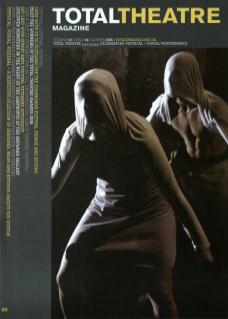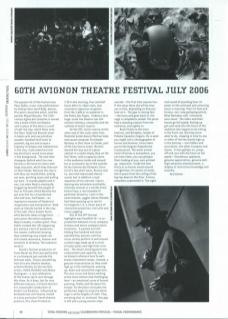The popular hit of the Festival was Paso Doble, a two-man performance by Serbian born Josef Nadj, dancer, this year’s associate artist, and the painter Miquel Barcelo. The 12thcentury Eglise des Celestins is turned into a state of the art theatre and in place of the altar is a wall of soft red clay, which flows onto the floor. Nadj and Barcelo enter in black suits and use primitive wooden-handled farm tools to pummel, dig out and scrape a tapestry of shapes and indentations in the clay. A persistent but lowkey electronic sound score plays in the background. The men then disappear behind what has now become a 3D mural to return with large clay pots, which they then put on their heads. Because the clay is soft they can mould them, poking out eyes, pinching noses and pulling out ears. It sounds playful and it was, but when Nadj is eventually staggering beneath the weight of four or five pots which Barcelo has put over him he is transformed into half man, half beast – an impressive moment of theatrical imagination and manipulation. Nadj ends up literally buried in the clay of the wall, like a human fossil, while Barcelo takes a large hose and covers the entire sculpture, Nadj included, in white paint. Paso Doble invoked the ’60s happening but without a hint of pretension. Two master craftsmen showing that something very simple can still create resonance, humour and moments of alchemy. The audience loved it.
Brook’s Festival production of Sizwe Bandi est Mort was performed in a schoolyard just outside the old town walls. Classic storytelling from this wily theatre shaman, acted brilliantly by the two Mali actors, Habib Dembélé and Abdoo Ouologuen – a real celebration of the human spirit runs through this show. As it does, but for very different reasons in French director Eric Lacascade’s production of Gorky’s Les Barbares. Influenced by Grotowski but still heavily rooted in a very particular French theatre practice, this show finished at 2.30 in the morning, four and half hours after its 10pm start, and received a rapturous reception from the 1,600 or so audience in the Palais des Papes. Evidence that large-scale live theatre can still achieve intimacy, sensuality and the subtlest of erotic nuance.
On the OFF, erotic nuance at the other end of the scale came from Montréal butoh dancer Martine Viale and sound composer Christophe Bailieau in their show La Sonde, part of the City Sonics event. Martine danced her way out of a glass cabinet in a small empty shop on the Rue Thiers, with a capacity seven in the audience inside and around ten or so passers-by on the outside. At the Caserne des Pompiers Clara Cornil’s two short solos, Bruisse and La, also had improvised electrosound, but in addition a mad sequence of live clarinet. Clara’s dancing was extremely watchable, intensely sensual in a weirdly there kind of way, a real example of performer presence. Later in the same theatre, juggler Adrien Mondot had them queuing up to see his Convergence 1.0, a clever piece of interactive projection, live cello and classy juggling.
One of the OFF Festival highlights was Parallèle 26 – a coproduction between circus company Archaos and dance company Sylvie Guillermin. A packed out tent holding five hundred and more watched four dancers and four circus artists perform in and around a metal cage made up of a circle of metal poles and high level cross bars. The show’s starting point was containment and captivity, but no blatant reference here to well-known internment camps: instead, a genuine incarnation as they crawl high up in the metal work, weaving up, down and around the cage bars. This was circus and dance working at the most intense and challenging level – an emotional score of human yearning, frailty and the desire for escape. As the piece concludes the performers begin to wrap the whole cage in white lengths of cloth. They are being shut in, enclosed. One gap is left and a young woman steps outside – the first time anyone has. If she stays there she will be shut out or free, depending on how you look at it. The gap is closing fast – she turns and goes back in, the cage is completely sealed. The piece had a standing ovation from the audience, and rightly so.
Back finally to the main Festival, and Bartabas, leader of Théatre Equestre Zingaro. He is what you might call a choreographer of horses and humans. A bus takes you to the Avignon Hippodrome (racecourse). The warm animal smell of horses is everywhere, you can hear them, you can glimpse them looking at you, ears pricked up, inquisitive. Inside the tent thirty or so horses stand around a bright blue-lit column of water, which pours from the ceiling of the big top down to the floor. A horse meanders underneath it. The sight and sound of pounding blue-lit water on the unmoved and unmoving horse is stunning. Then it’s fast and furious, non-stop galloping action. What Bartabas calls ‘créscendo sans cesse’. The riders and their horses go full speed, kicking up grit and sand into the faces of the audience who happen to be sitting in the front row. But they know what to do, clapping in time to one or other of the two bands high up in the balcony – one fiddles and accordions, the other trumpets and drums. A man gallops on, jumps off and runs with the horse at full speed – thunderous applause, genuine appreciation, genuine skill. High adrenalin entertainment, a display of instinctive knowledge and wizardry.

